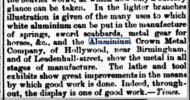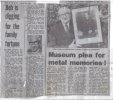Up till now I was not aware of him, despite myself being a chemist, and he appears to be a relatively unknown person, though in the 1880s he played a significant part in the development of a metal much used today - aluminium. He also (post 1327 at https://birminghamhistory.co.uk/for...nickets-of-old-brum.33053/page-67#post-643429 ) might have a relationship with one of our members , though this might be the coincidence of names.
Virtually all the information I have is from one article in the Birmingham Post in 1955, which is below. James' address in 1881 is given as Fern House, Ryland Road , Edgebaston, which is no longer there.

He had already developed a method for making steel which was cheaper than the Bessemer Process at the Denmark works 28 Freeth St, and presumably had made money from this. The site of this is shown on the c1889 map below.

After much development work he finally developed a method for the manufacture of aluminium in (for then) large quantities. Though his process still needing sodium metal, it was much more efficent and cheaper. Webster then set up a works, described as in Hollywood or Solihull Lodge, the position of which is shown in blue on the map below as "Crown Works (Aluminium)". The firm was known as the Crown Metal company. A rather rural position for an industrial factory, but conveniently beside the canal. What surprises me is that I had never noticed it before.

The company seems to have been quite successful , established another plant in Sheffield, and is mentioned in several exhibitions. The firm carried on for several years,


The sodium used in the process was, however still rather expensive , but Hamilton Castner, an American , had developed a superior method for sodium manufacture .
snubbed by his American countrymen he came over to England to develop his process. He, combined with other industrialists built a factory in Oldbury on land purchased from Chance Bros, and in 1887 took over the Crown Metal Company to form a new larger company named The Aluminium Company. This maintained production at Oldbury till 1891, when a new electrolytic process replaced the use of sodium metal.
Virtually all the information I have is from one article in the Birmingham Post in 1955, which is below. James' address in 1881 is given as Fern House, Ryland Road , Edgebaston, which is no longer there.

He had already developed a method for making steel which was cheaper than the Bessemer Process at the Denmark works 28 Freeth St, and presumably had made money from this. The site of this is shown on the c1889 map below.

After much development work he finally developed a method for the manufacture of aluminium in (for then) large quantities. Though his process still needing sodium metal, it was much more efficent and cheaper. Webster then set up a works, described as in Hollywood or Solihull Lodge, the position of which is shown in blue on the map below as "Crown Works (Aluminium)". The firm was known as the Crown Metal company. A rather rural position for an industrial factory, but conveniently beside the canal. What surprises me is that I had never noticed it before.

The company seems to have been quite successful , established another plant in Sheffield, and is mentioned in several exhibitions. The firm carried on for several years,


The sodium used in the process was, however still rather expensive , but Hamilton Castner, an American , had developed a superior method for sodium manufacture .
snubbed by his American countrymen he came over to England to develop his process. He, combined with other industrialists built a factory in Oldbury on land purchased from Chance Bros, and in 1887 took over the Crown Metal Company to form a new larger company named The Aluminium Company. This maintained production at Oldbury till 1891, when a new electrolytic process replaced the use of sodium metal.



